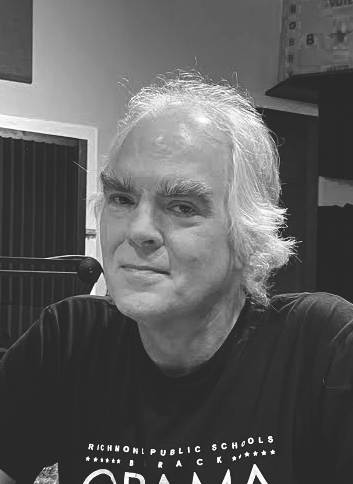The VMFA’s Storied Strings: The Guitar in American Art gives the guitar its solo.

Photo by Sandra Sellars, © 2022 Virginia Museum of Fine Arts
Leo Mazow says that the first thing people want to know about Storied Strings: , the guitar-centric exhibition he’s assembled at the Virginia Museum of Fine Arts (VMFA), is what kind of famous shredders will be on display.
“While we do have some of the earliest surviving American guitars in the show, and a few played by famous musicians,” says the VMFA’s Louise B. and J. Harwood Cochrane Curator of American Art, “those guitars are exactly what have inspired American artists, from the 19th century to today.”

Buttressed by a $40,000 grant from the National Endowment for the Arts, Storied Strings: The Guitar in American Art, which opens Oct. 8 at the VMFA, will be the first major exhibition to survey the guitar in American art. In more than 125 carefully chosen pieces, it explores the instrument’s omnipresence in American life, starting with its days as a 19th-century ladies’ parlor instrument to its modern transformation into Woody Guthrie’s protest tool, emblazoned with the message: “This machine kills fascists,” and the rock ‘n’ roll axes wielded by Jimi Hendrix and Led Zeppelin’s Jimmy Page.
“The guitar has long enabled artists to tell stories that are undertold or not told at all,” says Mazow, who once curated a similar exhibition on the banjo at the Palmer Museum of Art at Penn State University. From Thomas Cantwell Healy’s 1853 portrait of Charlotte Davis Wylie fingering the frets to Dorothea Lange’s Depression-era photograph of a strumming Mexican laborer, the images offer a window into the nation’s soul.
Storied Strings will also house a glass-encased music studio where, once a week during the show’s run, a series of notable guitarists will hold live recording sessions as visitors look on and listen. The players will include popular Australian virtuoso Tommy Emmanuel, avant-folk artist Yasmin Williams, and Nels Cline, the celebrated lead guitarist for alt-rock band Wilco.
The goal, he says, is to “unpack the guitar’s storytelling potential.” The recordings will be filmed, mixed, and uploaded to the VMFA’s website and YouTube as “The Richmond Sessions,” in homage to the 1927 Bristol Sessions, which is known as the Big Bang of commercial country music.
“The themes explored in Bristol ranged from courtship and Christianity to trains and transportation, to mortality and well beyond,” Mazow says. “As with those 1927 sessions, it is my hope that these recordings will enlist the guitar in a thoughtful exploration of personal relationships, national identity, popular religion, and a sense of place.”
What the guitarists choose to record is up to them. “This is certainly going to be a first,” says MacArthur prize-winner Corey Harris, who admits he’s tickled at the prospect of appearing in a museum exhibition. “But I guess the growth comes when you are out of your comfort zone.” The Charlottesville-based blues and reggae musician says his input “will center around Virginia blues—John Jackson, John Cephas. It’s important to feature the Piedmont blues in this.”
Mazow, who also plays guitar, is a big fan of Wilco and the Jayhawks, whose touring lead guitarist Stephen McCarthy has advised him on the project. But he insists that he didn’t play favorites with the exhibition’s lineup.
“I think it’s a pretty daunting task to mount an exhibit on the guitar because of all of the different genres and periods—we’re talking centuries, really,” McCarthy says. “But Leo is a smart, driven guy and, yeah, it’s ambitious because that’s what he does.” The Richmond-based McCarthy has written an original song specifically for Storied Strings and will record with multi-instrumentalist Charles Arthur.

Odetta, 1958, Otto Hagel (American born Germany 1909–1973). Photograph by Otto Hagel. Collection Center for Creative Photography, © Center for Creative Photography, The University of Arizona Foundations, 98.117.66

Jessie with Guitar, 1957, Thomas Hart Benton (American, 1889–1975) Jessie Benton Collection. Image © 2022 T.H. and R.P. Benton Trusts/Licensed by Artists Rights Society (ARS), New York

Romare Bearden (American, 1911–1988) Three Folk Musicians, 196750. Virginia Museum of Fine Arts, Richmond. Arthur and Margaret Glasgow Endowment.
“The guitar made a strong appearance in American life and it hasn’t gone away,” says composer Joel Harrison, author of Guitar Talk: Conversations with Visionary Players. “You can play both simple and complex music on the guitar. It’s the only instrument, aside from the accordion, that is both harmonic and portable, where you can accompany yourself and sing. You can’t drag a piano around with you.”
The Brooklyn-based Harrison says that his Richmond session with fellow guitarist Anthony Pirog will display the instrument’s range. “It’s amazing what people have been able to get out of the same 12 notes.”
“All of these folks are great guitar players,” Mazow says of the musicians he’s assembled. “But they are also storytellers. They use guitars to approach themes that perhaps wouldn’t be appropriate out of the blue in conversation.”
While the performances highlight the guitar as storyteller, the visual art illustrates how it has influenced American art. “Guitars are recurring props in portraits,” Mazow says. “People feel comfortable holding the guitar; it might cover their body, it might fit in their lap. There’s also this trope of individuals holding guitars like a child, like Madonna and child.”
During its five-month run, Storied Strings will also feature a film series, lectures, a build-a-cigar-box-guitar event for kids—and, finally—more than 30 rare, one-of-a-kind guitars, including the very first custom-painted Fender Stratocaster and gorgeous specimens fretted and sweated on by Eric Clapton, Freddie King, Brian Setzer of the Stray Cats, and John Lee Hooker. “So, yeah,” Mazow says, “there will be guitars.”
Storied Strings runs from Oct. 8, 2022-March 19, 2023 at the Virginia Museum of Fine Arts. VMFA.museum
This article originally appeared in the October 2022 issue.








